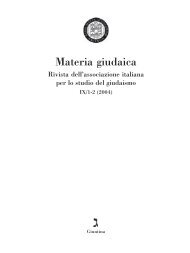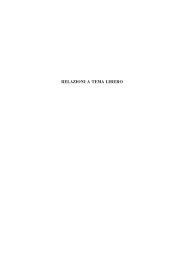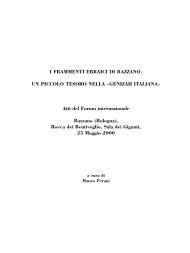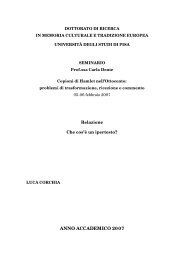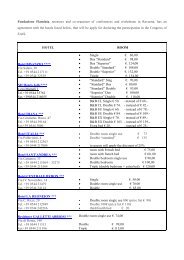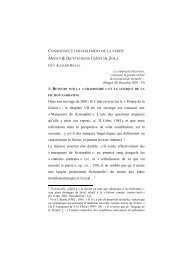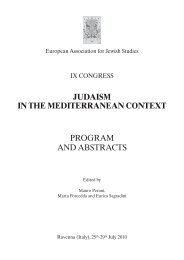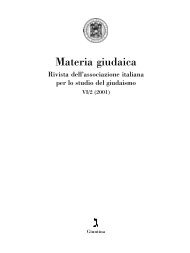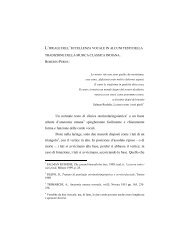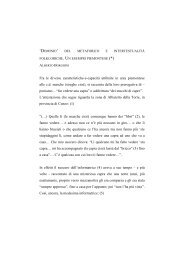161 Abraham Gross GERONA: A SEPHARDIC CRADLE OF ...
161 Abraham Gross GERONA: A SEPHARDIC CRADLE OF ...
161 Abraham Gross GERONA: A SEPHARDIC CRADLE OF ...
You also want an ePaper? Increase the reach of your titles
YUMPU automatically turns print PDFs into web optimized ePapers that Google loves.
Ezra Chwat<br />
one sentence later, a reference to an opinion<br />
raised by Nahmanides in his sermon for Rosh ha-<br />
Shanah is titled . This peculiar<br />
term appears 11 times in Yom Tov Asevilli’s<br />
Novellae, usually in reference to Nahmanides as<br />
it is here, describing an idea that Nahmanides is<br />
at it’s foundation, and has been transmitted<br />
through his students. It’s a term used to attribute<br />
authorship in the loosest sense of the word. It’s<br />
used by Nahmanides and other European scholars<br />
in attributing Ba-Midbar Rabbah to Mosheh<br />
ha-Darshan.<br />
For contrast, this term does not appear<br />
even once in all the volumes of Shelomoh ibn<br />
Aderet’s works, Novellae and Responsa. Yet one<br />
should be wary of relying on this method.<br />
On the last page is a mention of Maimonides<br />
as . In Yom Tov Asevilli on<br />
Alfasi (Ta‘anit), for comparison, Maimonides<br />
appears more often than any other source, even<br />
Nahmanides, and almost always appears after the<br />
words .<br />
This reflects his position as a bottom-line<br />
decision maker, but not as a participant in the<br />
debate. This is typical of the Geronese Alfasi compositions<br />
prior to Nissim Gerondi.<br />
Yet we have no reference among the<br />
Geronese scholars to Maimonides as , a<br />
term derived from the Arabic Muallif – composer,<br />
which is why it is first found in Ibn Tibbon, of<br />
12 th century Provence, but remained there, to<br />
become the standard term for Maimonides in<br />
Menahem ha-Meiri of 14 th century Provence.<br />
Even so, this is no reason to disqualify Yom<br />
Tov Asevilli from the authorship of this composition,<br />
precisely because it is that: a composition<br />
of previous sources.<br />
Such is the case in this passage, in which<br />
the author is redacting and incorporating an article<br />
by Isaac of Narbonne, a native of Provence,<br />
into his composition.<br />
Though we haven’t reached a positive conclusion<br />
whether or not Yom Tov Asevilli is the<br />
author of this ms., any advancement towards the<br />
identification is well worth the effort.<br />
There is a talmudic tradition that when a<br />
great talmudist is quoted, his lips move his grave<br />
to recite the quotation. This is a reflection of how<br />
our culture appreciates its intellectual giants of<br />
the past. Unlike in Italy we do not erect statues<br />
to commemorate our heroes, because their words<br />
are their legacy. A true talmudist does not quote<br />
Yom Tov Asevilli, for example, with the term<br />
«Yom Tov Asevilli said» rather, in the present<br />
tense, «Yom Tov Asevilli says» as if his written<br />
words are living.<br />
With this in mind we of the Jewish National<br />
Library, and the Jewish people as a whole, are<br />
indebted to the efforts of Prof. Mauro Perani and<br />
his supporters in Bologna.<br />
In their work they should always remember,<br />
that every word that is reclaimed from these<br />
texts is not merely a matter of preservation, it is<br />
a matter of revival.<br />
Ezra Chwat<br />
The Institute of Microfilmed Hebrew Manuscripts<br />
Jewish National and University Library, Jerusalem<br />
POB 34165 Jerusalem 91341 - Israel<br />
e-mail: ezrac@vms.huji.ac.il<br />
SUMMARY<br />
A 32-page manuscript fragment, recently discovered in the Gerona archives, is a copy of a glosssupplement<br />
on the Alfasi Code, tractate Rosh ha-Shanah, and was possibly written by Yom Tov Asevilli.<br />
This is an example of a Rabbinic genre which was one of the most prolific and productive fields of Rabbinic<br />
literature between the twelfth and thirteenth centuries throughout the Rabbinic world. When compared<br />
to parallel texts of this genre produced in the Geronese school founded by Nahmanides, one can<br />
discern the role it played in the stages of development and refinement of these works.<br />
KEY WORDS: Gerona Ms. fragment, Alfasi gloss-supplement, identifying.<br />
190



